Welcome to Atlantis Evidence. The search for a Lost Civilization!
I shall present on this site evidence for a long forgotten history of our planet. Our planet is literally covered in unanswered questions about our past. I have gathered together the most fascinating pieces of evidence that I have been able to find in the past 15 years of my life.
Number 5 = Tiwanaku/Tiahuanacu and Pumapunku in Bolivia.
Archeology generally dates Tiwanaku to 1500 BCE as a small agriculturally-based village, it has not always been attributed this date. The first investigator, Prof. Arthur Posnansky, a Polish engineer dedicated fifty years to the study of Tiwanaku(Spanish: Tiahuanaco), dated its origins to 15,000 BCE this date is based on various evidence including several varieties of physical and astronomical data.

The gate of the sun the 10 ton gateway of the Sun was first discovered beneath several feet of clay silt, face down, and broken in half (the result of seismic disturbance; Posnansky, 1945). It is monolithic, originally formed from a single block of Andesite granite. Its upper portion is decorated with beautiful and intricate designs, including a human figure, condors, toxodons*, elephants* and symbols
There are a number of other reasons this site is so fascinating: Pumapunku is a large temple complex complete with a huge dock located one mile from Tiwanaku, at its peak Pumapunku is thought to have been "unimaginably wondrous". Lake Titicaca which is now 12-15 miles from Pumapunku is the nearest body of water, which imply's a very early date for the construction of the site. If water has receded 12-15 miles from the dock how long has this taken?
Pumapunku is filled with enormous stone blocks weighing between 100 and 150 tons! One block still in place weighs an estimated 440 tons! These blocks have been carried over 20 miles uphill from the quarry site. Some of the blocks are held together by large metallic, I-shaped couplers others were held together by silver rivets. The system used here is reminiscent of that used in the Egyptian ruins on Elephantine Island on the Nile among other places in the world including the Pacific (David H Childress ref on that last point). Many researchers believe that the metal was actually poured into I-shaped slots carved into the rock. If this is the case the builders must have had access to a portable smelting device to pour molten metal into the blocks once they were in situ. This is rather advanced technology to have around, let alone possibly as far back as 15000BCE!
"The processes and technologies involved in the creation of these temples are still not fully understood by modern scholars". David Hatcher Childress
TO assemble the walls of Pumapunku, each stone was very finely cut to interlock with the nearby stones and the blocks fit together like lego bricks. One engineering technique they used was shaping the top of the lower stone at a certain angle, and placing another stone on top of it which was cut at exactly the same angle. The precision with which these angles have been formed is solid evidence for a highly sophisticated knowledge of stone working. Many of the joints are so precise that not even a cigarette paper will fit between the blocks. Today we use Diamond saws to cut granite. It's that hard. The blocks at Pumapunku have grooves that are completely straight, and of uniform depth(see pic).
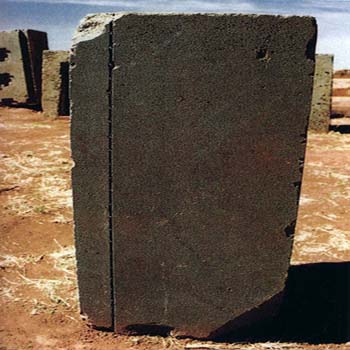
and tooled holes within the line.
The ruins of Pumapunku, about one mile from the ruins of Tiahuanaco, are huge megalithic constructions that are tossed about like building blocks. What kind of cataclysmic upheaval could have caused such destruction? Megalithic construction meant to last for thousands of years, yet the 100+ ton blocks have been ripped apart by what we can only assume were mighty geological forces.
The Evidence suggests the whole South American continent was violently thrust upward during some kind of ancient cataclysm, possibly a pole shift? A former sea-level canal can now be seen at 13,000 feet in the Andes Mountains. As possible evidence for this scenario, many ocean fossils can be found near Lake Titicaca. The lake is even inhabited by the only known fresh water sea horses. Posnanky also noticed that the ruins were generally covered by a thin layer of lime deposits, evidence that they had been underwater for a long period of time.
*Elephant Cuvieronius is an extinct New World genus of gomphothere. It is named after the French naturalist Georges Cuvier, stood 2.7m (9 ft) tall and looked like a modern elephant except for its spiral-shaped tusks. Cuvieronius was a mixed feeder, and has been dated at least as recently as 9,100 B.P. in South America. It is very hard to judge from the pictures I have seen if this is actually an elephant but it's an interesting point that many well known authors such as Graham Hancock seem to have latched on to.
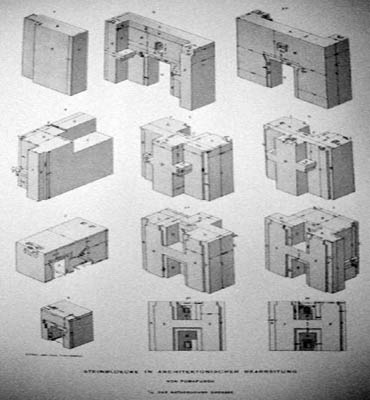
Highlands of Ancient Peru) 1892 by two German
engineers Alphons Stubel and Max Uhle.
* Toxodon is an extinct mammal of the late Pliocene and Pleistocene epochs about 2.6 million to 16,500 years ago. It was indigenous to South America, and was probably the most common large-hoofed mammal in South America at the time of its existence. Once again it is very hard to judge from the pictures I have seen if the Toxodon is actually represented or another similar looking animal.
The video above gives a much better insight into the sheer scale and engineering tour de force of Pumapunku.
In summing up the evidence, as the whole plateau seems to have been lifted from sea level in the ancient past and the buildings were clearly destroyed in this process. If this happened in the time scale archaeologists would have us believe it would be a significant event. No doubt Europe would have been caught up in it as well and would be recorded in our written history as well as our cultural memory! There is one event that is recorded around the world of this magnitude the Great Flood (future article to follow on this subject) of the bible (The Great Flood is also mentioned by almost every culture around the world in some form)Who was in Bolivia over 10000 years ago with a highly sophisticated society? hopefully one day we will get the answer.
Further reading Atlantisquest.com I recommend reading the section POSNANSKY'S DATING TECHNIQUE near the bottom of the page.
Number 4 = Mohenjon-daro. Earliest known pre planned town with sewers and water to each home circa 2600BCE
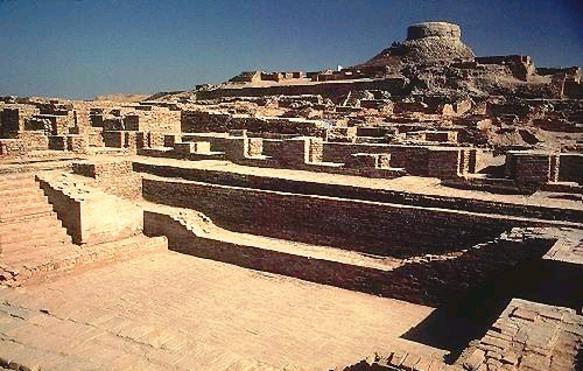
We think of Rome as advanced, here is a civilization that accomplished most of what the Romans did but 2600 years earlier!
- Chert weights system possibly for trade with each unit weighing approximately 28 grams, similar to the English Imperial ounce
- Unique Harappan inventions include an instrument which was used to measure whole sections of the horizon
- Metallurgy and produced copper, bronze, lead and tin.
- Various sculptures, seals, pottery, gold jewelry and anatomically detailed figurines in terracotta, bronze and steatite
- Many crafts "such as shell working, ceramics, and agate and glazed steatite bead making" were used in the making of necklaces, bangles, and other ornaments

- Some make-up and toiletry items (a special kind of combs (kakai), the use of collyrium and a special three-in-one toiletry gadget)
- Seals have been found at Mohenjo-daro depicting a figure standing on its head, and another sitting cross-legged in what some call a yoga-like pose (Lotus position according to my Yoga teacher) see gold pic to the right
- A harp-like instrument depicted on an Indus seal and two shell objects found at Lothal indicate the use of stringed musical instruments
- There was an extensive maritime trade network operating between the Harappan and Mesopotamian civilizations
- Well over 400 distinct Indus symbols have been found on seals, small tablets, ceramic pots and over a dozen other materials, including a signboard
- The earliest evidence for elements of Hinduism are present before and during the early Harappan period
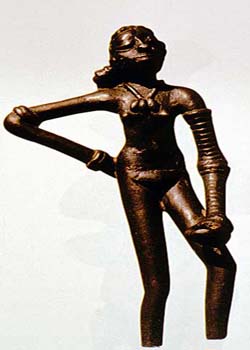
Mohenjo-daro
Sir John Marshall is known to have reacted with surprise when he saw the famous Indus bronze statuette of a slender-limbed dancing girl
in Mohenjo-daro.
"When I first saw them I found it difficult to believe that they were prehistoric; they seemed to completely upset all established
ideas about early art, and culture. Modeling such as this was unknown in the ancient world up to the Hellenistic age of Greece, and I thought,
therefore, that some mistake must surely have been made; that these figures had found their way into levels some 3000 years older than those
to which they properly belonged. Now, in these statuette's, it is just this anatomical truth which is so startling; that makes us wonder whether,
in this all-important matter, Greek artistry could possibly have been anticipated by the sculptors of a far-off age on the banks of the Indus".
A wonder to modern-day academics, the city was extremely advanced for the time and caused leading archaeologists to believe that they were pre-planned before one brick was laid: a truly remarkable early example of city planning. Even more extraordinary is that the plumbing-sewage system throughout the large city is superior to some found in Pakistan, India, and Asian countries even today!
Fantastic photos of Mohenjo-daro c2600bc
Number 3 = Mehrgarh in Pakistan and Dwarka(Dvaraka) Giant Underwater City Found In India.
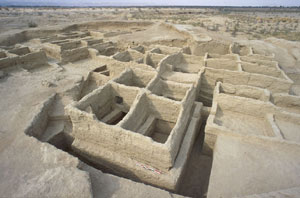
© Jarrige for more information
please follow this link Musee Guimet
Mehrgarh, (Urdu:) one of the most important Neolithic (7000 BCE to circa 2500 BCE) sites in archaeology, lies on what is now the "Kachi plain" of today's Balochistan, Pakistan. It is one of the earliest sites with evidence of farming (wheat and barley) and herding (cattle, sheep and goats) in South Asia." Located near the Bolan Pass, to the west of the Indus River valley and between the present-day Pakistani cities of Quetta, Kalat and Sibi, Mehrgarh was discovered in 1974 by an archaeological team directed by French archaeologist Jean-Francois Jarrige, and was excavated continuously between 1974 and 1986. The earliest known settlement at Mehrgarh in the northeast corner of the 495 acre site was a small farming village dated between 7000 BCE - 5500 BCE.
To the south east we find Dwarka carbon dating on a log dredged up, carried out by the Birbal Sahni Institute of Palaeobotany (BSIP) and the National Geophysical Research Institute (NGRI), suggested that it could be as old as 7,500 BCE and these settlements could easily be the oldest neolithic sites discovered in India. The underwater studies conducted by the ASI (Archeological Survey of India) reveals the existence of a city dated to the 2nd millennium BCE. The search for the lost city was going on since the 1930's. The Marine Archeology Unit (MAU) of the National Institute of Oceanography, joined this search in 1983. The search was carried out in the coastal waters of Dwarka in Gujarat. Explorations between 1983 and 1990 finally revealed the fortified township of Dwarka, under the sea that extended more than half a mile from the shoreline.

Among the objects unearthed that proved Dwarka's connection with the Mahabharata epic was a seal engraved with the image of a three-headed animal possibly a dog. The Mahabharata mentions such a seal given to the citizens of Dwarka as a proof of citizenship when they wanted to leave or re-enter the city.
Other evidence from the recent underwater excavations that has backed up the Mahabharata include Dwarka was built in six sectors along the banks of an ancient river. The foundation of boulders on which the city's walls were built proves that the land was reclaimed from the sea. The epic has references to such reclamation activity at Dwaraka. "Towards the end of the most recent Dvarpara Yuga, the texts tells us,Dwarka was a fabulous city founded on the north-west coast of India. Established and ruled over by Krishna, it was built on the site of an even earlier sacred city, Kususthali, on land that had been reclaimed from the sea".The general layout of the city of Dwarka (built in six sectors)described in ancient texts agrees with that of the submerged city discovered.
Dvaraka Giant Underwater City found off India
Dr. S R Rao has written:
"The discovery of the legendary city of Dwaraka which is said to have been founded by Sri Krishna,
is an important landmark in the history of India. It has set to rest the doubts expressed by historians about the historicity of Mahabharata and the very
existence of Dwaraka city. It has greatly narrowed the gap in Indian history by establishing the continuity of the Indian civilization from the Vedic Age to the
present day."
Much like the search for Troy by Heinrich Schliemann which finally found Troy near Truva, in Hisarlik in Anatolia, Turkey Dwarka was found by believing ancient "myths" are based on actual accounts of history. What other ancient tales can help us reconstruct the past of humanity?
Number 2 = Sphinx dating circa 7000BCE. The Mystery of the Sphinx dvd
hosted by Charlton Heston and based on the
work of John Anthony West
On November 10, 1993, the NBC television network broadcast "The Mystery of the Sphinx," introducing thirty million American viewers (watched by circa 250 million people to date)to the discovery by John Anthony West and Robert Schoch that the Great Sphinx of Giza might be thousands of years older than its assumed date of 2500 BCE.
Narrated by Charlton Heston, the documentary provides evidence that the ancient Egyptians possessed scientific knowledge unknown to us and carried on the wisdom tradition of an earlier lost civilization.
"When ideas change, everything changes" - John Anthony West.
Number 1 = Gobekli Tepe in Turkey circa 9,500BCE the Oldest Temple known in the World. Is it the true Garden of Eden?
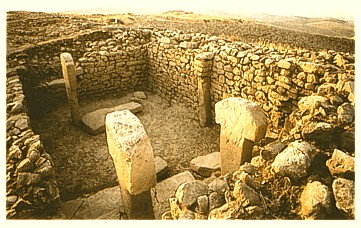
I present Gobekli Tepe in Turkey as the number one evidence of our lost past. Excavations have been conducted since 1994. Any comments about the site must be considered preliminary, about 5% of the site's total area has been excavated to date by the one-acre excavation.
Archaeologists led by German Klaus Schmidt have found evidence for tool use, including stone hammers and blades. And because those artifacts closely resemble others from nearby sites (Catal Huyuk - the oldest Neolithic city anywhere in the world and Karahan Tepe, a site only discovered in the late 1990s) previously carbon-dated to about 9000 B.C. Schmidt and co-workers estimate that Gobekli Tepe's stone structures are the same age. Limited carbon dating undertaken by Schmidt at the site confirms this assessment. Schmidt believes that Gobekli Tepe's artwork has connections with the Eden story, the relief's on the pillars include foxes, lions, cattle, wild boars, wild asses, herons, ducks, scorpions, ants, spiders, many snakes, and a very few anthropomorphic figures. Schmidt says archaeologists could dig here for another 50 years and barely scratch the surface.
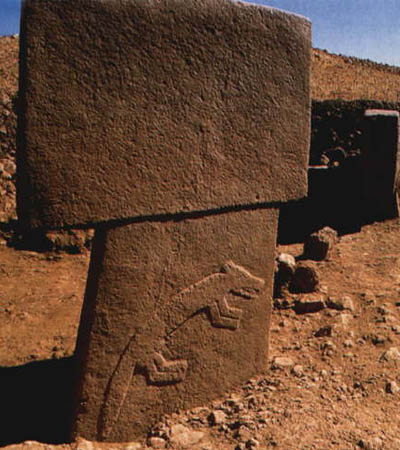
A broken, half-quarried rock was found in a limestone bed about a kilometer from the main site. It is nine meters long, archaeologists believe it was intended to join the pillars at Gobekli. There could be other stones, as yet unexcavated, that are this big or even larger. Geomagnetic surveys show that there are at least 250 more standing stones buried at the Gobekli Tepe site.
At present, Gobekli Tepe raises more questions for archaeology and early prehistory than it answers. We do not know how a force large enough to construct, build, and maintain such a massive complex was organised and fed in the conditions of pre-Neolithic society. We cannot "decipher" the pictograms, and have no idea what meaning the animal relief's had for the builders of the site; the variety of fauna depicted, from lions and boars to birds and insects, makes any single explanation difficult. It is hard to imagine why more and more walls were added to the interiors while the sanctuary was in use, with the result that some of the engraved pillars were hidden. The reason the complex was eventually buried also remains unexplained. Considering that only a fraction of the site has so far been excavated, these and other mysteries may eventually be solved.
"Gobekli Tepe is regarded as an archaeological discovery of the greatest importance, since it profoundly changes our understanding of a crucial stage in the development of human societies".
Nevali Cori was an early Neolithic settlement on the middle Euphrates, in the province of Sanliurfa (Urfa), eastern Turkey. The site is famous for having revealed some of the world's most ancient known temples and monumental sculpture. Together with the site of Gobekli Tepe, it has revolutionised scientific understanding of the Eurasian Neolithic.
Update February 2014 - Gunung Padang Indonesia
Recently the remote ancient site of Gunung Padang Indonesia has been visited by Graham Hancock and Robert Schoch. You can read an interesting article from Graham Hancock here.
In brief, a survey conducted in 2012 showed the following: The site was dated to 6,500 years BP (before present) carbon radiometric dating was used at 3–4 metres below the surface. At 8 to 10 metres below the surface dates of 12,500 years BP were discovered. The artifacts at the surface date to about 4,800 years BP.
I contacted Dr. Schoch and he very kindly supplied me with the following information.
"Short preliminary comments on Gunung Padang By Robert M. Schoch and Catherine Ulissey, December 2013 www.robertschoch.com
Gunung Padang does appear to be a site that was constructed by humans. How long ago is the big question, but some very early dates, based on radiocarbon analyses, that geologist Dr. Danny Hilman Natawidjaja and his team are finding (circa the end of the last ice age, about 12,000 years ago, and earlier) do seem to suggest we are looking at something very old. The site needs much further study, though; these are preliminary findings.
The blocks themselves were formed by nature, by volcanic activity millions of years ago during the Tertiary period. They are igneous (specifically andesite) and were formed by natural volcanic processes. However, and this is very important, they form VERTICALLY in nature and are called by geologists “columnar joints” or “columnar jointing”. The issue at Gunung Padang is that they have definitely been taken from their natural vertical positions and laid down (arranged by man) horizontally to create the structures at this site. There are definite and distinct comparisons to be made to Nan Madol in Micronesia. It is our feeling that the blocks were not quarried a distance away and then transported, but rather they probably occurred right there on site in this tectonically active region and were simply repositioned to form the ancient structures. It is also interesting that cavities or chambers have been found, using geophysical techniques, below the surface at Gunung Padang; they have yet to be explored.
As of now, no definitive artifacts have been found in association with the site (no sculpture, pottery, art, etc.). Perhaps more detailed excavations might reveal something along these lines. However, just as there is a push for broader excavation of Gunung Padang, so too is there opposition to it. It is a sacred site to many and they do not want it touched."

Conclusions
Generally we are taught at school that civilization started in Sumeria around 4000BCE the evidence on this web site clearly shows there was a lot going on in the world a long time before that. More evidence seems to be presenting itself recently and I can only hope a lot of the questions raised on this site will be answered in the not too distant future.
Could it be that civilization was nearly totally wiped out at the end of the last ice age? Our ancient ancestors surviving in a few mountains from the great flood that myths all over the world talk about? In which case they would have needed to restart human civilization from a much lower base of knowledge than pre-flood. Most of their towns would be submerged along the coasts by a sea level up to 300 feet higher than before.
The aim of this site is to present information that is easily understood and backed up as much as possible with facts rather than speculation. A website that can be used as the start of a persons journey into ancient cultures and perhaps find the answers they are looking for. There is a lot of information on the Internet once you start looking into these subjects. However a lot of the information is fragmented and it can become hard to put all the pieces of the puzzle together for the casual researcher. I wanted to find a way to share the important information in an accessible format.
I will be updating this site regularly with more information. I encourage everyone to investigate the areas of interest to them. If you have any comments or questions on source material that I have used please get in touch. Email us